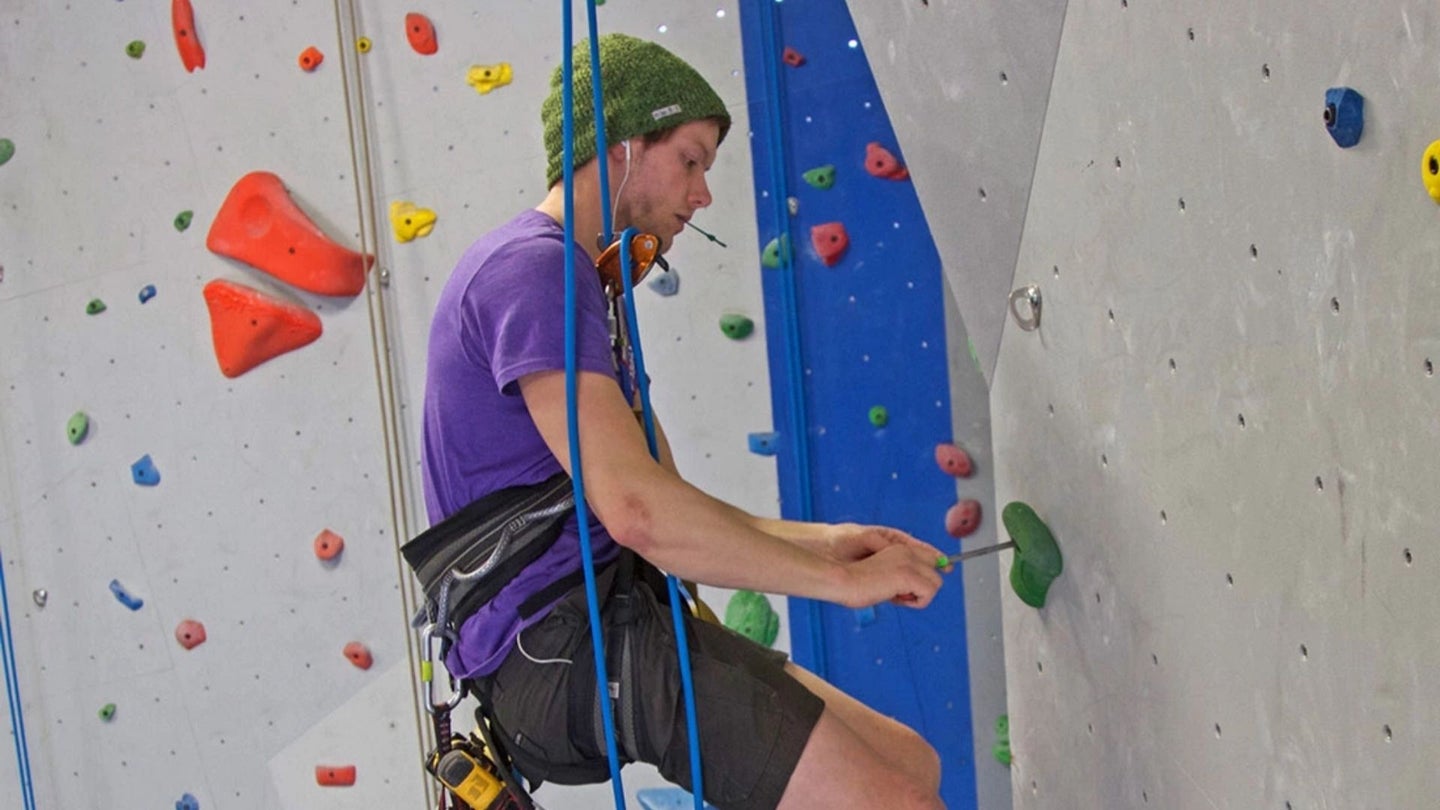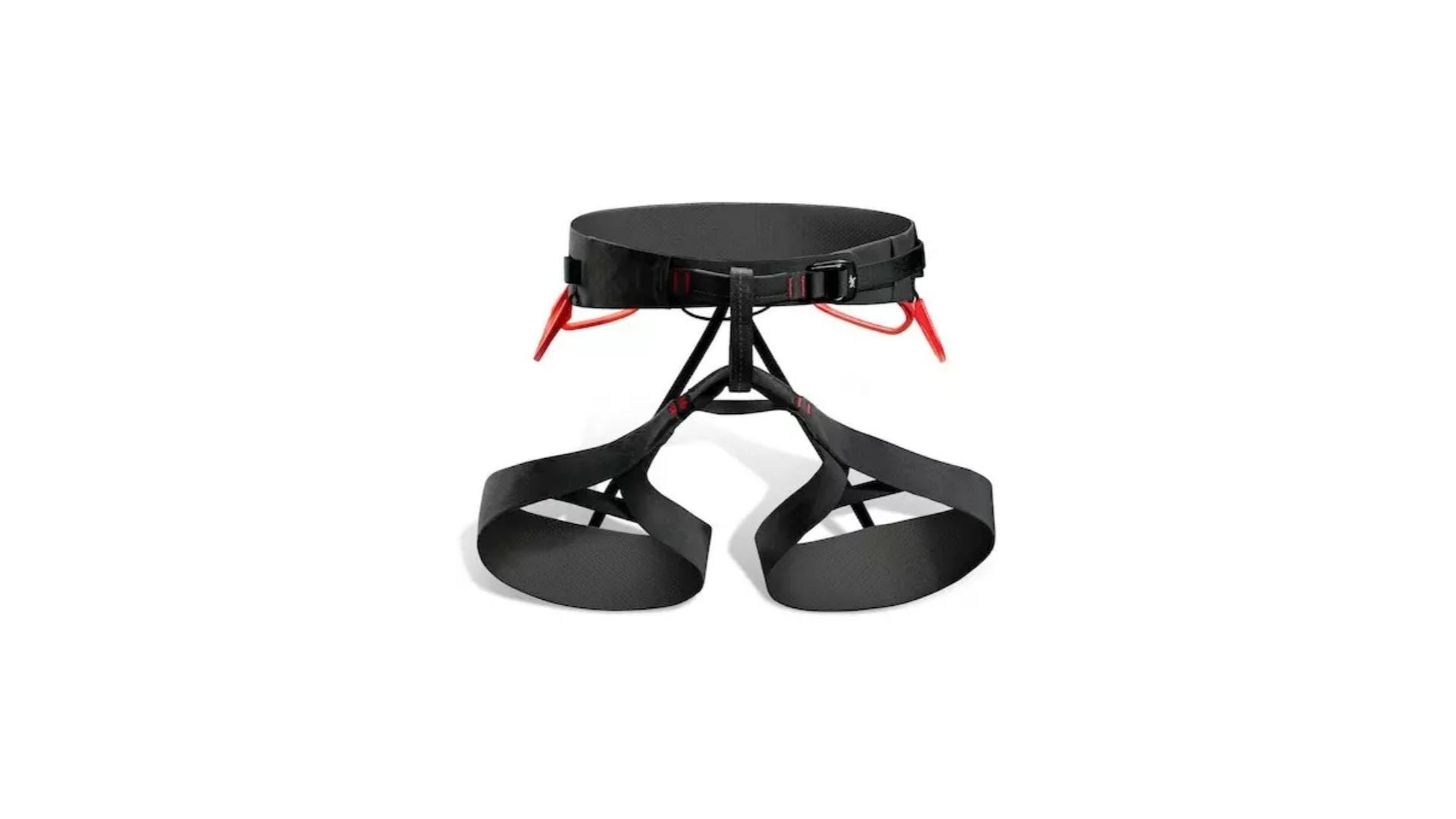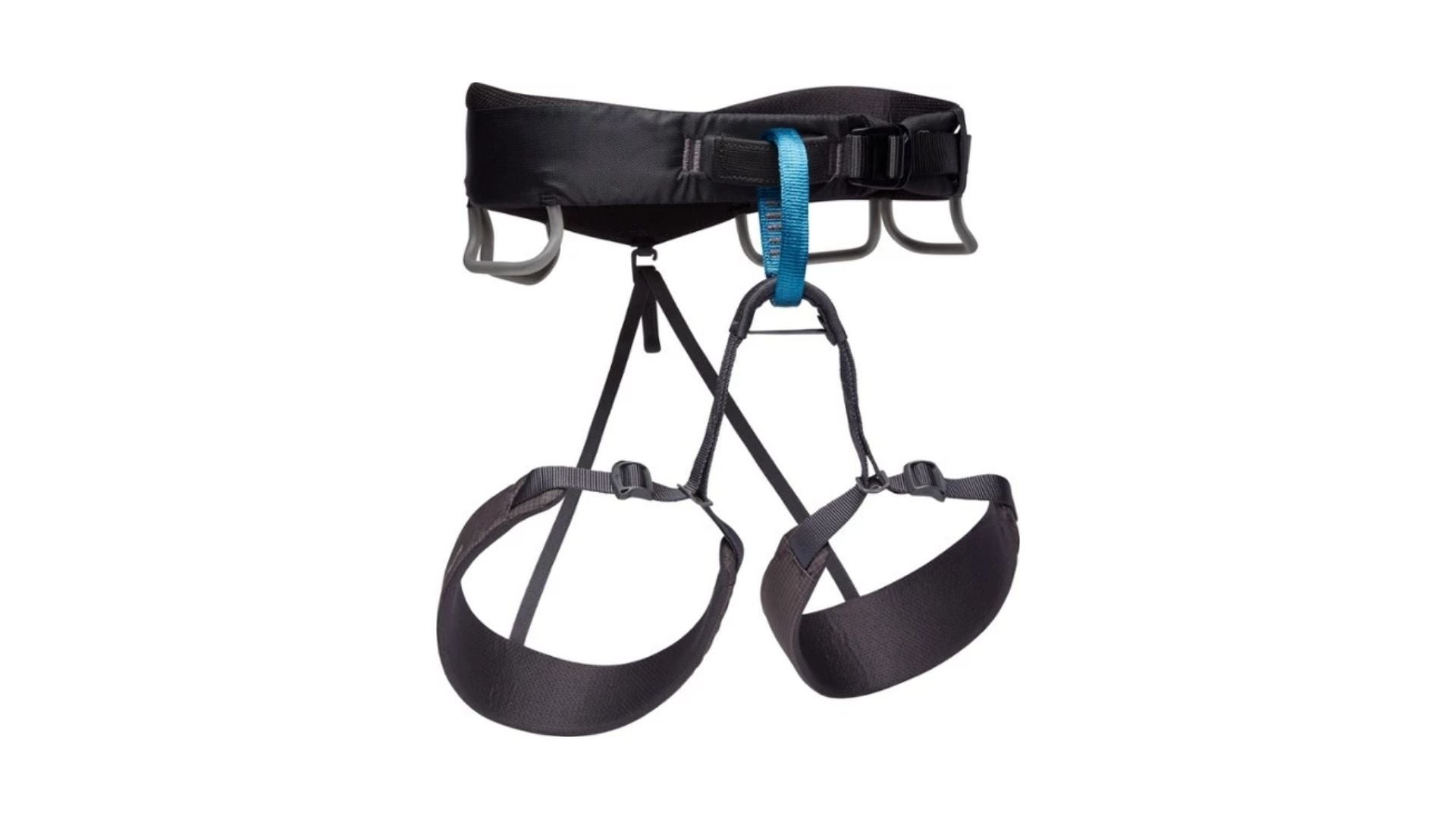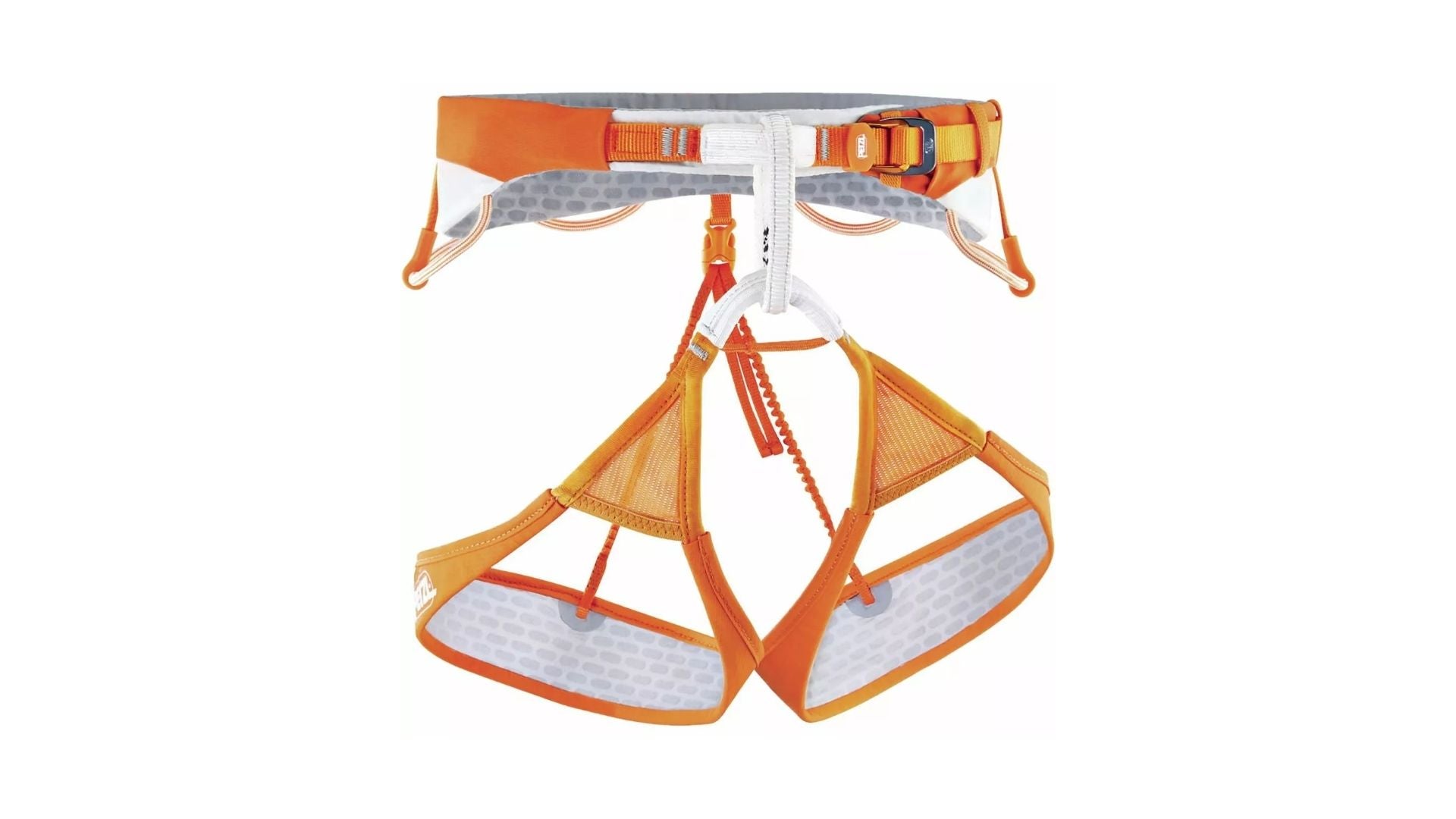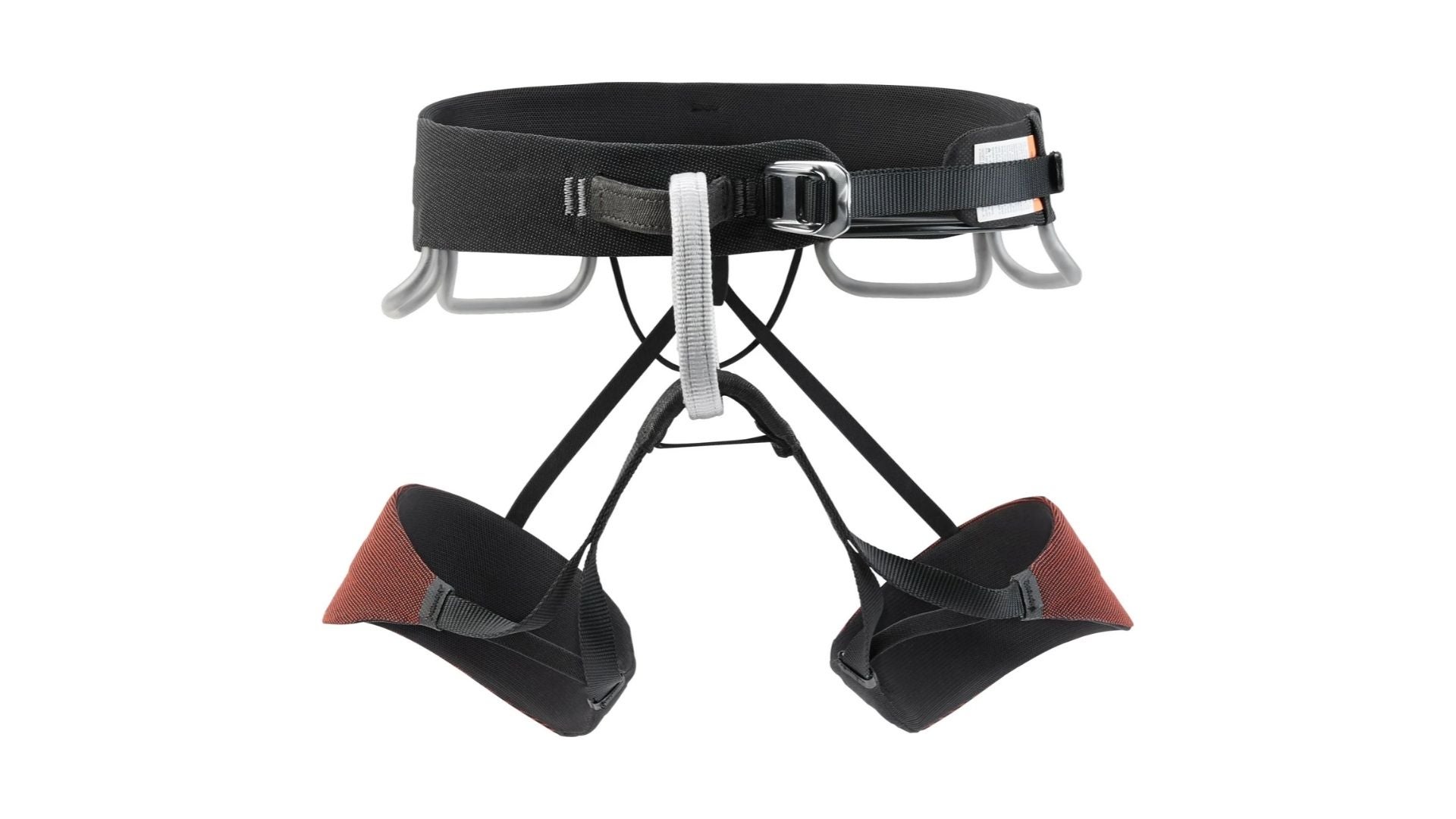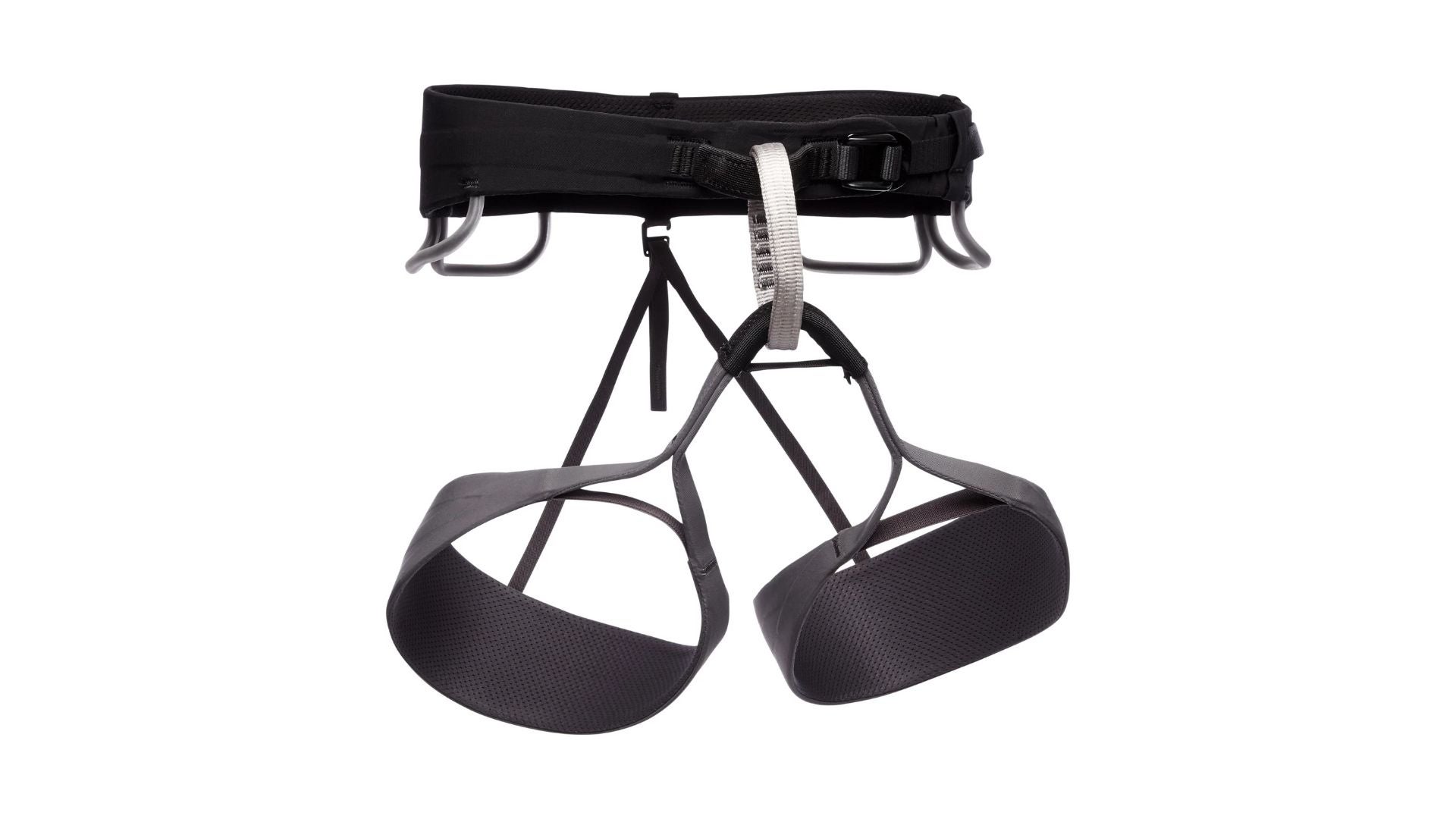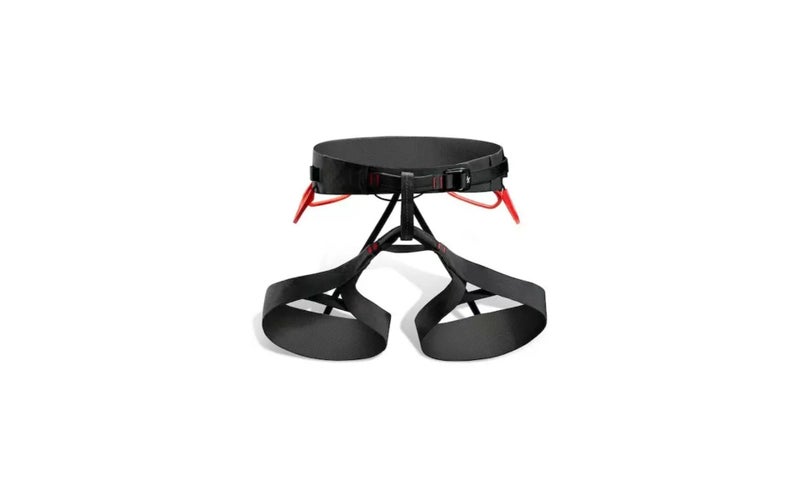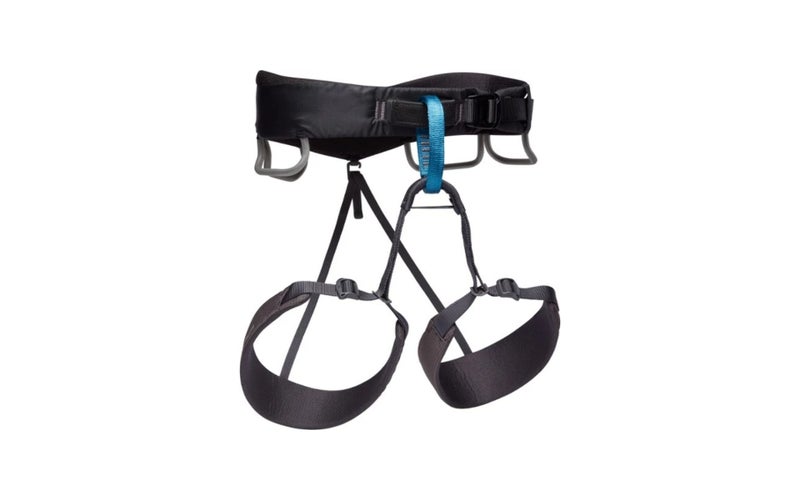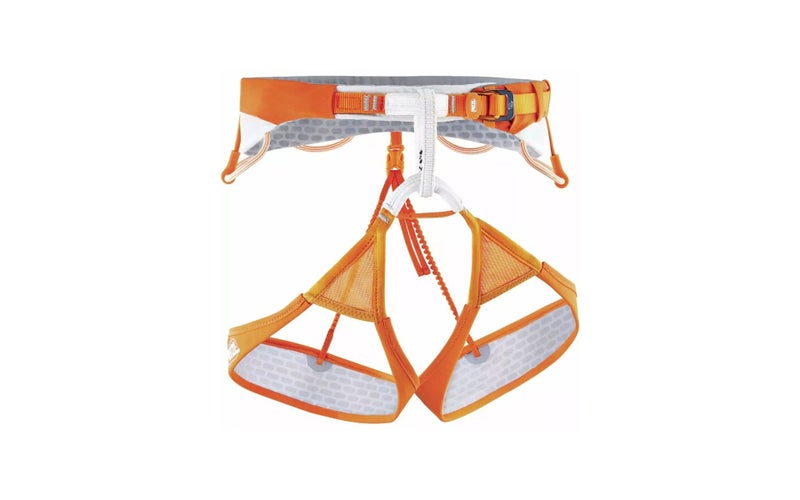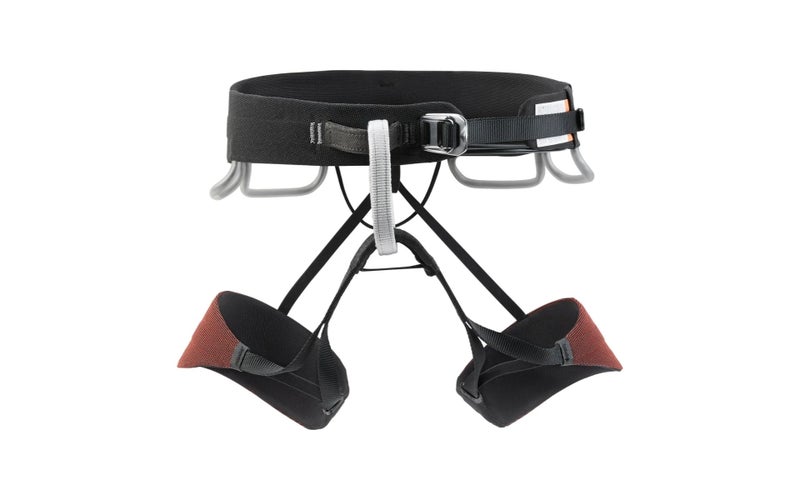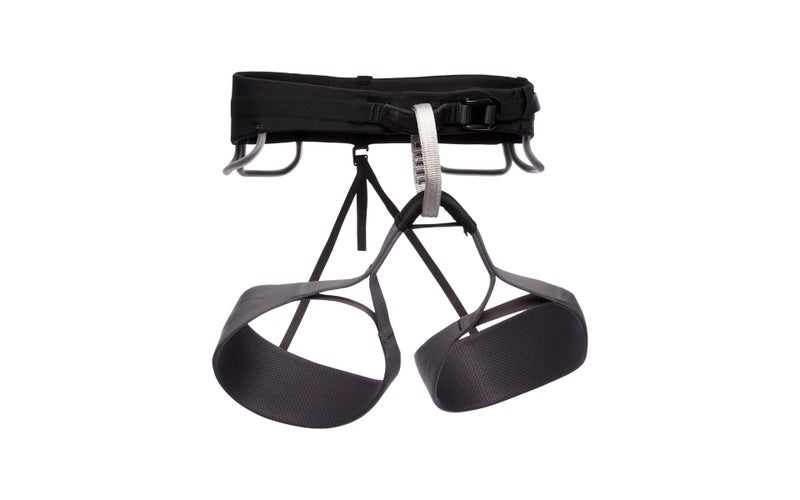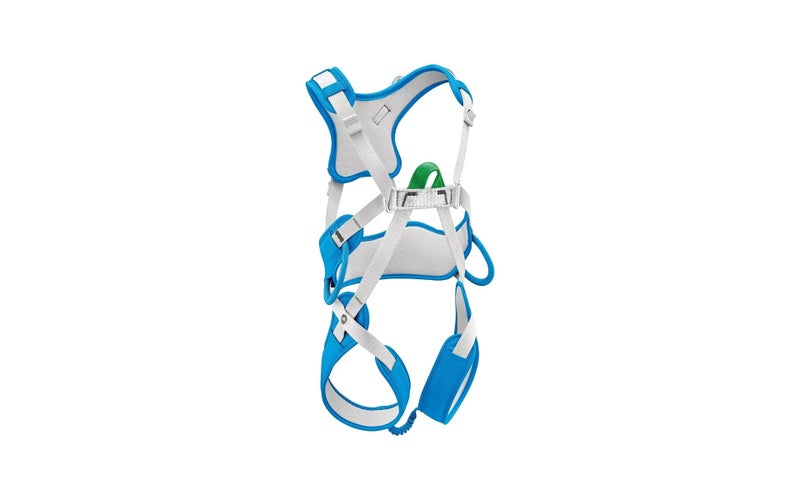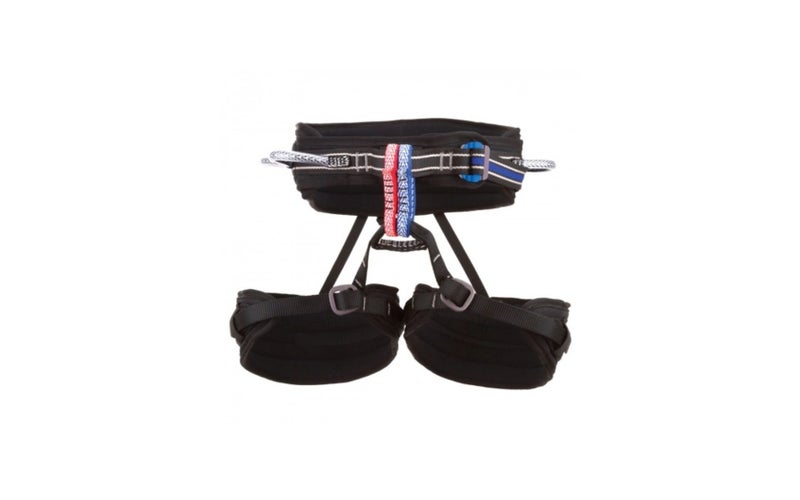We may earn revenue from the products available on this page and participate in affiliate programs.
Climbing harnesses serve as essential gear, both when you’re climbing at the crag and at your local gym. Unless your specialty is exclusively bouldering, you’ll want to invest in a well-fitting harness. The goal is to find one that you barely notice you’re wearing, but you’ll certainly remember it when it catches you on that slippery crimp hold.
Climbing harnesses come in a variety of materials with features differing depending on what type of climbing you’ll be doing. From beginner routes at the gym to multi-pitch ascents, a harness is your lifeline, ensuring that if you fall, you’ll live to climb that route again.
Below, we’ll go over our top picks for the best climbing harnesses, explain who they’ll fit best, and cover a few FAQs when it comes to shopping for a rock climbing harness.
- Best Overall: Arc’teryx C-Quence
- Best Budget: Black Diamond Momentum
- Best for Men: Petzl Sitta
- Best for Women: Black Diamond Women’s Solution Guide
- Best for Beginners: Black Diamond Solution
- Best for Kids: Petzl Ouistiti
- Best Heavy-Duty: Metolius Safe Tech Waldo
When it comes to outdoor gear, Arc’teryx is a leader in thoughtful design and performance-driven materials. Its rock climbing harnesses are no exception, and the C-Quence ranks as our best overall harness.
Coming in both a men’s and a women’s version, the C-Quence is an ideal combination of breathable but padded materials so it doesn’t pinch or cut into your legs or waist while you’re on the wall. Some customer reviews say it’s the most comfortable harness they’ve ever worn and they occasionally forget to take it off — it’s that unnoticeable. In the world of searching for the best rock climbing harnesses, this is the Holy Grail.
A few noteworthy features of the C-Quence include its use of Arc’teryx technology designed to evenly distribute your weight throughout the harness so it doesn’t feel like one single strap is holding you up. The back of the harness also features a stainless steel quick hook that disconnects the leg loops from the waistband of the harness — incredibly convenient for long days at the crag when nature calls and you’d rather not take the whole harness off.
One downside to the C-Quence is that some climbers mention they had a tough time getting the sizing correct. Arc’teryx even states this harness has a different fit than its other harnesses and provides a detailed size chart to help you get the exact fit. Even better is if you can find the harness in a store to try it on before you buy.
- Weight: 370 grams/13.1 ounces (men’s medium); 355 grams/12.5 ounces (women’s medium)
- Designed for: rock, ice, and alpine climbing
- Gear loops: 5
- The thoughtfully designed Arc’teryx C-Quence remains comfortable to wear all day on long climbs with plenty of room for storage for alpine or ice climbing.
Uses Arc’teryx Warp Strength Technology to evenly distribute weight throughout the harness
Stainless steel quick hook to easily drop leg loops
Tie-in points and the belay loop are equipped with wear markers
Made with breathable materials
Can be tough to get sizing right
Less budget-friendly than most of our picks
As one of the best quality-to-value rock climbing harnesses, the Black Diamond Momentum earns our ranking of the best budget harness. Coming in both men’s and women’s, this is a great harness for anyone looking to keep to a budget. It could also be great for beginners who aren’t sold on sinking an entire paycheck into climbing gear just yet.
Not only is the harness fairly easy on the bank account, it’s also designed to be easy to put on. Both expert reviews and customer reviews mention how the pre-threaded waist belt makes for easy and quick adjustments. The leg loops use Black Diamond’s trakFIT design which can easily adjust to hot days while wearing shorts or cold days when you’re wearing bulkier pants.
As the brand’s most popular all-around climbing harness, the Momentum also has rigid gear loops which makes clipping and unclipping easy and could be another ideal element for beginners.
The Momentum is designed to be used for gym, sport, or trad climbing, but it has one caveat. It does the job on some trad climbs, but if you know you’re going to be lugging tons of gear with you, these gear loops could prove to be annoyingly small.
On the positive side, in both men’s and women’s, you’ll have two color options and at least five size options, which makes this one of the most inclusive designs to accommodate many body types — all at a budget price.
- Weight: 302 grams/10.7 ounces (men’s medium); 302 grams/10.7 ounces (women’s medium)
- Designed for: sport, gym, and trad climbing
- Gear loops: 4
- The universally loved Black Diamond Momentum climbing harness is a great bang-for-your-buck harness to use for gym, sport, or trad climbs.
Pre-threaded waist belt buckle for quick adjustments
trakFIT leg loops can accommodate thicker layers for cold-weather climbs
Two color options in both men’s and women’s
Five size options in women’s; six options in men’s
Missing ice clipper slots
Gear loops are on the small side
Petzl’s Sitta men’s harness is made with top-of-the-line materials for an incredibly lightweight, supportive, and high-performance harness. The downside is that this comes with a rather high price. But if you’re looking for the best of the best when it comes to a men’s rock climbing harness, the Petzl Sitta could be the one.
With four gear loops, the Sitta is designed to function for trad, mountaineering, or sport climbing. It packs down well to not add bulk to your climbing pack. While the harness feels incredibly comfortable while climbing, it’s remarkably thin and lightweight. It’s made with Petzl’s Wireframe Technology, which is high-modulus polyethylene strands woven into the waist belt and leg loops. This takes the place of more bulky padding that most harnesses use.
The harness excels in versatility, also being designed to work as a mountain climbing harness thanks to its lightweight packability and versatility. Some reviews highlight its versatility by mentioning that it’s possible to hike and even ski while wearing the Sitta.
With impressive performance, the Sitta ranks as one of the most trusted men’s climbing harnesses on the market. While it doesn’t come cheap, many argue the price is well worth what you get.
- Weight: 270 grams/9.7 ounces (medium)
- Designed for: trad, sport, and mountaineering
- Gear loops: 4
- Impressively lightweight with unique technology and great functionality, the Petzl Sitta is one of the most versatile and well-performing men’s climbing harnesses available.
Minimalist design translates to a lightweight harness
Packs down well
Flexible and thin leg loops and waist belt use Wireframe Technology
More expensive than many harnesses
The women’s Black Diamond Solution Guide builds on the original design of BD Solution, but this harness features a female-specific fit. The best climbing harness for women is likely to be designed to fit a female figure with a narrower waist and wider hips when compared to a men’s. To accommodate this difference, women’s climbing harnesses have a longer rise, or distance between the leg loops and the waist belt, which is the exact case with the Black Diamond Women’s Solution Guide.
Durability reigns supreme with the Solution Guide since it’s made of the company’s Super Fabric which is infused with tiny guard plates that make it abrasion-resistant — a huge plus should you drag it across some rough rock. The one slight negative to Super Fabric is it’s a bit stiffer than some rock climbing harness material, which means this one is a little less comfortable to wear when not climbing. This technical material also adds to the higher-than-average price point. On the flip side, the extra durability could mean a longer lifespan for the product.
Some climbers are turned off by the harness’ leg loops which are fixed rather than adjustable. But if you can get the fit right, the BD Solution Guide is a great rock climbing harness with a women’s cut.
- Weight: 362 grams/13 ounces (medium)
- Designed for: trad and multi-pitch climbing
- Gear loops: 5
- With a higher rise to fit feminine figures, the Black Diamond Women’s Solution Guide offers excellent durability and comfort on the wall for multi-pitch and trad climbing.
Large gear loops
Comfortable for all-day climbs with a well-padded waist belt
Excels in durability with Black Diamond’s Super Fabric
Stiff to walk around with off the wall
Not as adjustable as some harnesses
Learning how to rock climb can be an intimidating task. The last thing you want to deal with is uncomfortable gear that doesn’t perform the way it should. To help ease beginners into the world of climbing, the Black Diamond Solution serves as a great entry-level harness. It packs in a ton of features for being a lightweight harness and it’s one of the more affordable options on the market.
The Solution is equipped with four gear loops, which is likely plenty for a beginner. If you’re going on multi-day trad climbs, the loops are probably too small to fit your entire rack, but we’re assuming beginners won’t be signing on for such an adventure. But for gym or sport climbing, the Solution offers ample room for gear.
The harness shines when it comes to being comfortable. Black Diamond uses Fusion Comfort Technology in the waistband that helps evenly distribute weight across the harness and leg loops. The primary fabric used in the harness is Bluesign-certified, which means it’s produced using methods that reduce the impact on the environment and those working to produce the harness.
An all-around solid, reliable, and comfortable performance from the Solution makes it a great choice for those learning how to rock climb.
- Weight: 330 grams/11.64 ounces (medium)
- Designed for: gym and sport climbing
- Gear loops: 4
- The Black Diamond Solution offers the perfect trifecta of a rock climbing harness for beginners: It’s comfortable, incredibly functional, and it’s reasonably priced.
Uses Bluesign-certified fabric for a more eco-friendly harness
Incredibly comfortable, so beginners can focus on the climb
Waist belt uses Fusion Comfort Technology to cut down on weight
Small gear loops
The Petzl Ouistiti wins our top pick for the best climbing harness for kids. It’s a full-body harness that is widely considered to be the safest choice for most children. As adults, our center of gravity lies in our torso through the hips, the heaviest part of our bodies. Kids tend to have a much higher center of gravity, so the full-body harness gives better support to the upper torso and head.
The harness is fully padded, with a design emphasis on comfort to make sure even the pickiest kid won’t hate it once it’s on. It has adjustment buckles on the shoulders as well as on the back to help get the best fit possible. As a bonus, the buckle locations are nearly impossible for a fidgety kid to access.
The full-body Ouistiti is also comfortable to sit in, which could happen often on the wall as a child gets more accustomed to climbing. Off the wall, it doesn’t limit movement, so kids are free to run around at the base of the wall while still wearing the harness without feeling like it’s in the way.
Climbing harness reviews point out that this kid’s model has two gear loops, and it’s unlikely that your kid needs to be carrying two loops worth of carabiners or quickdraws up the wall. Instead, one loop could be used to take along a favorite toy or stuffed animal which could be great for helping to calm nerves and boost confidence. Plus, that toy would gain serious bragging rights about the views and activities they’ve experienced.
- Weight: 410 grams/15.4 ounces
- Designed for: top rope
- Gear loops: 2
- The Ouistiti is a well-designed climbing harness for kids that hits the perfect hybrid of a full-body harness for ultimate safety while being comfortable enough to play around all day.
Full-body harness best for kids
Buckles are difficult for child to reach while wearing
Comfortable, padded straps throughout
Only fits kids up to 66 pounds
Some climbing trips call for a heavy-duty harness. For these, you’ll want a harness suited for big-wall climbs and trad climbing that are designed to help you haul lots of gear.
With six gear loops (five in size small), the Metolius Safe Tech Waldo fits the bill with a comfortable design. If your climb requires extra gear, it’s likely a big wall that’ll leave you spending hours attached to heavy gear. Metolius designed the Safe Tech Waldo rock climbing harness to help haul that extra weight as painlessly as possible. With plenty of padding and a fleece lining, reviews across the board mention how comfortable the harness is through the longest days.
It’s also a favorite among route-setters at gyms who often climb with a heavy bucket of hardware and hold it behind them for extended amounts of time.
If you’ll be spending more than a day on the wall, your adventure might also call for using a great climbing pack for gear and food storage.
Don’t expect a lightweight harness with the Safe Tech Waldo. All the extra padding, support, and gear loops come at the cost of added weight. It’s also not incredibly breathable because of those materials. But you’re probably going to be dripping sweat on a multi-pitch climb while hauling trad gear regardless of your harness.
- Weight: 794 grams/28 ounces (medium)
- Designed for: big wall or multi-day climbs; route-setters
- Gear loops: 6 (medium and large); 5 (small)
- With plenty of room for gear, the Metolius Safe Tech Waldo matches comfort with versatility on long trad climbs, and it comes in a wide range of sizes.
Four sizes available
Plenty of gear loops
Ideal for big-wall climbs or route-setters
Fleece-lined for comfort and to reduce any chafing
Heavy
Isn’t the best for breathability
Things to consider before buying a climbing harness
It’s possible to buy a cheap climbing harness (in price, not in quality), but others come with a hefty price tag. Before investing in a rock climbing harness, we recommend taking the following elements into account to make sure you’re getting the best gear for your money.
Type of climbing
Climbing harnesses are designed with different types of climbing in mind. Each type of climbing has its own ideal functionality of a harness. For example, a lightweight harness could be best for sport climbing at the gym, while a trad harness is necessary for multi-pitch routes where you’ll be hauling tons of gear.
The first step in deciding which harness is right for you is deciding which type of climbing you’ll be using it for. Do you need something with plenty of gear loops, or is padding for long days on the wall the number one priority? These questions will help narrow down what’ll work best.
Climbing gear budget
When it comes to buying climbing gear, your harness could be one of the cheaper items on your shopping list. Considering it could save your life, it seems well worth the investment. Our top budget pick comes in at under $70, but some harnesses can cost upward of $200. If budget is a consideration, you should be able to find a suitable harness for under $100. If you’re a beginner and the cost of getting started with climbing seems daunting, consider buying your ideal harness and a lightly used pair of climbing shoes to help even out costs (climbing shoes are notorious for inducing sticker shock).
Return policy
On paper, you may have found what you hope to be the best rock climbing harness, but this is pretty comparable to buying a pair of pants. Sure, you get the sizing right, but sometimes it just doesn’t feel great once you try it on. It’s difficult to decide how comfortable (or uncomfortable) a rock climbing harness will feel until you actually climb with it on. Because of this, it could be worthwhile to invest in a harness that comes with a decent return or exchange policy should you decide it’s not the perfect fit.
FAQs about climbing harnesses
Q: Can you rock climb without a harness?
A: Yes, you can climb without a harness. If you’ve seen the award-winning documentary Free Solo with legendary climber Alex Honnold, your palms dripped with sweat as he climbed a massive wall without a harness or rope. But most of us feel a heck of a lot more comfortable climbing with a harness. Should you lose grip of a hold or experience a foot slip, a rock climbing harness is there to catch your fall. It’s also possible to rock climb without a harness if you’re bouldering. Rather than scaling big walls, bouldering is climbing on shorter routes that usually don’t go higher than 15 feet.
Q: Is there a difference between men’s and women’s climbing harnesses?
A: Yep, men’s and women’s climbing harnesses are different. The primary difference is in the rise of the harness, and the distance between the leg loops and the waist belt. Rock climbing harnesses designed for feminine figures have a longer rise when compared to men’s. It’s also common for women’s harnesses to have smaller leg loops, but that’s not always the case, especially if they’re adjustable.
Q: How should a climbing harness fit?
A: The fit of your rock climbing harness is incredibly important to how comfortable you’ll feel while wearing it and also plays into its functionality. An ill-fitting harness could be dangerous and lead to injury if you were to fall. Experts say a rock climbing harness should feel snug but not pinch anywhere. The typical rule of thumb is that you should be able to fit two fingers or less between the harness and your body in both the waistband area and the leg loops. The exception to this rule is if the leg loops have elastic material so the stretch might allow for more room.
Final thoughts
Arc’teryx steals the show with the C-Quence climbing harness which comes in both a men’s and women’s version. Thoughtful design elements like breathable material and a quick hook in the back add to the comfort and convenience.
Methodology
To decide on the best rock climbing harnesses, we looked into 15 brands that make climbing gear. Most of those manufacturers make several climbing harnesses which made for an initial list of 38 harnesses. We then excluded new-to-the-market harnesses since we can’t get a holistic view quite yet of how the harness will hold up over time.
We took into account the purpose of each harness (sport climbing, trad, ice, etc.) and weighed features of each. Since harnesses are often designed for gender, and kids have different requirements, we opted to include a top pick for each.
We also did a price comparison to make sure one wasn’t charging an arm and a leg for standard ho-hum materials. If the price was above average, we made sure the product reflected above-average construction, material, or function. Overall, we narrowed down the list to find the climbing harnesses that offered the best features matched with being comfortable to wear.
